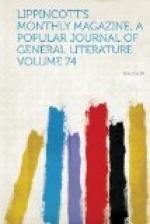As the train approaches its destination the passengers see in the distance the three cerros of Paraguari. These isolated sugar-loaf-shaped hills called cerros, covered with verdure, are a marked feature of Paraguayan scenery. They rise from the flat plains, and although their isolated situations impart to them an appearance of great height, they are rarely more than four hundred feet above the level of the plain. Paraguari comprises fifty or sixty houses worthy of the appellation, built around a square. In the outskirts are numerous mud-huts, all well populated with women and children. Its inhabitants number about three thousand, and in its quality as terminus of an unfinished railroad it has that flavor of desperadoism which usually attaches to positions of that kind. Here gather malefactors, generally of foreign birth, from Asuncion and elsewhere—refugees from the central authority and the metropolitan police—who are more free in Paraguari to prey on whomsoever chance may throw in their way. Of the sixty houses, twelve are tiendas, shops in which are sold at retail English cotton goods, Hamburg gins, etc., in exchange for the products of the country—hides, tobacco, mate and other commodities.
The Paraguayan is an inveterate gambler, and in Paraguari two at least of the houses are devoted to public play. They are crowded nightly, and often the stakes amount to five hundred or a thousand francs. Quarrels frequently arise over the play, and then the knife is brought into requisition, but the affrays are due more to the presence of the Italian, Argentine and Brazilian adventurers who flock there than to the Paraguayans, who are not, naturally, a quarrelsome race. On the night of his arrival, M. Forgues, with revolver in belt and accompanied by his Swiss friend, walks through the village. The tiendas are lighted up, but the other houses are in darkness. They look in on the gamblers. The dingy room is partially illuminated by a petroleum lamp which hangs from the ceiling and casts its rays on groups of men with hang-dog countenances seated or standing around a long table, smoking pipes and playing at cards for silver coin, or else engaged in a certain game played on a billiard-table, in which a handful of small balls is thrown on the table by the players, the end to be attained being to cause as many of the balls as possible to enter the pockets. Then M. Forgues and his companion leave the scene of the gambling orgie and look on another phase of life in Paraguari after dark. Not far distant is a lighted stable-lantern on the ground: around it, with a confused medly of ponchos and white skirts flying in the air, goes on the merry dance to the sound of an organ’s whining notes. This is all that can be seen from where they stand, for the faces of the dancers, too dark to be distinguishable in the night, are invisible.




